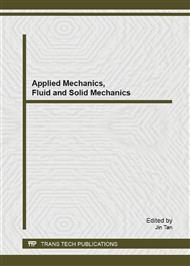[1]
D. W. Bradley and A. M. Tyrrell. Immunotronics - Novel Finite-State-Machine Architectures with Built-In Self-Test Using Self-Nonself Differentiation. IEEE Transactions on Evolutionary Computation. Vol. 6, p.227–238 (2002).
DOI: 10.1109/tevc.2002.1011538
Google Scholar
[2]
M. Chandrashekhar; R. Ganguli. Structural damage detection using modal curvature and fuzzy logic. Structural Health Monitoring, USA, v. 8, n. 4, pp.267-282, (2009).
DOI: 10.1177/1475921708102088
Google Scholar
[3]
D. Dasgupta. Artficial Immune Systems and Their Applications,. Springer-Verlag New York, Inc., Secaucus, NJ, USA, (1998).
Google Scholar
[4]
L. N. de Castro and J. TIMMIS. Artificial Immune Systems: A New Computational Intelligence Approach, Springer. 1st edition, (2002).
Google Scholar
[5]
S. Forrest; A. Perelson; L. Allen and R. Cherukuri. Self-Nonself Discrimination in a computer, Proc. do IEEE Symposium on Research in Security and Privacy, pp.202-212 (1994).
DOI: 10.1109/risp.1994.296580
Google Scholar
[6]
V. R. Franco; D. D. Bueno; M. J. Brennan; A. A. Cavalini JR.; C. G. Gonsalez; V. Lopes JR. Experimental damage location in smart structures using Lamb waves approaches. In: Brazilian Conference on Dynamics, Control and Their Applications – DINCON. pp.1-4. (2009).
Google Scholar
[7]
V. Giurgiutiu. Tuned lamb wave excitation and detection with piezoelectric wafer active sensors for structural health monitoring. Journal of Intelligent Material Systems and Structures, USA, v. 16, n. 4, p.291–305, (2005).
DOI: 10.1177/1045389x05050106
Google Scholar
[8]
S. R. Hall. The effective management and use of structural health data. In: International Workshop on Structural Health Monitoring, pp.265-275. (1999).
Google Scholar
[9]
M. Krawczuk; W. Ostachowicz; G. Kawiecki. Detection of delaminations in cantilevered beams using soft computing methods. In: Conference on System Identification and Structural Health Monitoring, Madrid, p.243–252 (2000).
Google Scholar
[10]
F. P. A. Lima; A. D. P. Lotufo and C. R. Minussi. Artificial Immune Systems Applied to Voltage Disturbance Diagnosis in Distribution Electrical Systems, Proceedings on IEEE PowerTech-2013, Grenoble, France, 6 p (2013).
DOI: 10.1109/ptc.2013.6652127
Google Scholar
[11]
Matlab (2011). 7. 8 Version, Mathworks Company.
Google Scholar
[12]
T. Shen; F. Wan; B. Song; Y. Wu. Damage Location and Identification of the Wing Structure With probabilistic neural Networks. Prognostics & System Health Management Conference (PHM 2011). p.1–6, (2011).
DOI: 10.1109/phm.2011.5939524
Google Scholar
[13]
C. Xiang-Jun; G. Zhan-Feng; G. Qiang. Application of wavelet analysis in vibration signal processing of bridge structure. International Conference on Measuring Technology and Mechatronics Automation. p.671–674, (2010).
DOI: 10.1109/icmtma.2010.95
Google Scholar
[14]
S. Zheng; X. Wang; L. Liu. Damage detection in composite materials based upon the computational mechanics and neural networks. In: European Workshop on Structural Health Monitoring, Munich, p.609–615 (2004).
Google Scholar
[15]
F. L. Wang; T. H. T. Chan; D. P. Thambiratnam and A. C. C. Tan. Damage Diagnosis for Complex Steel Truss Bridges Using Multi-Layer Genetic Algorithm. Journal of Civil structural Health Monitoring, Springer-Verlag, p.117–217, (2013).
DOI: 10.1007/s13349-013-0041-8
Google Scholar


